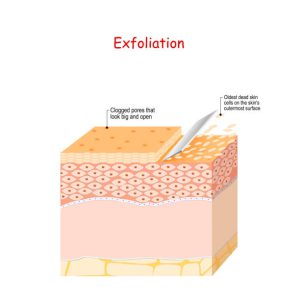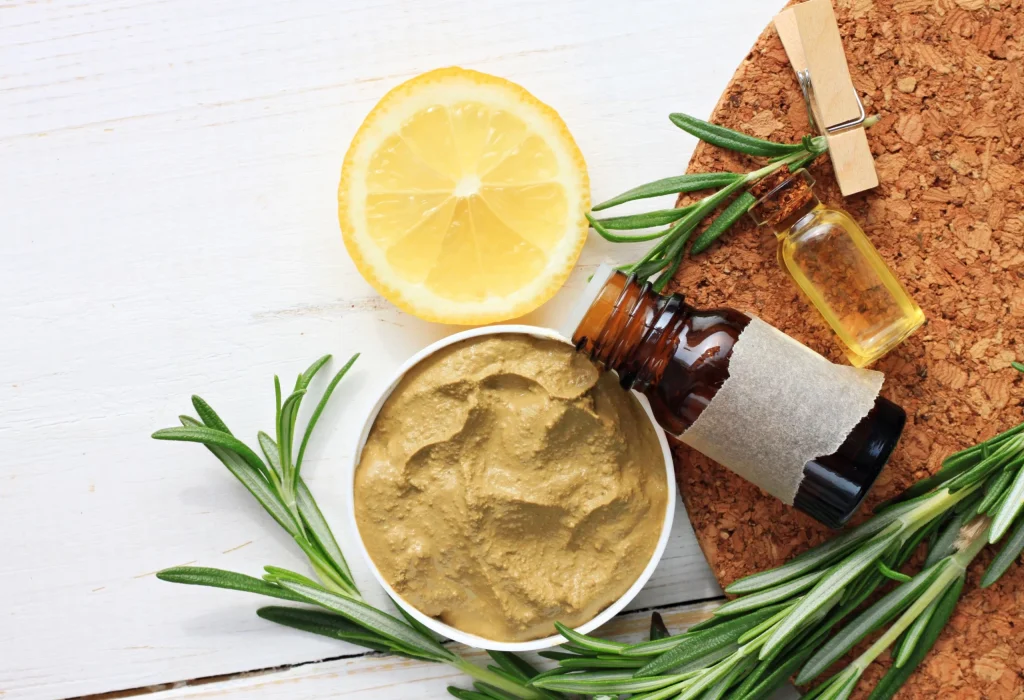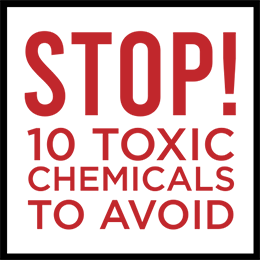We all know the feeling of our skin after a good exfoliation. It’s almost as if we can feel our pores breathing a sigh of relief. We’re not just imagining things, either!
The key to healthier, more radiant looking skin is probably the most overlooked step – exfoliation.
Our skin is in a constant state of renewal. New skin cells develop in the lower layers, while old skin cells work their way to the surface and die out. These dead skin cells then create a dull, lifeless appearance.
While this entire renewal process takes typically two to four weeks, this process slows down as we age. Exfoliating regularly accelerates the cell renewal process, revealing younger, healthier, more radiant-looking skin.
There are two basic types of exfoliation: physical and chemical. You can find these in:
- scrubs
- face masks
- toners and cleansers
- face peels
- moisturizers
1. What’s The Difference Between Chemical and Physical Exfoliation?
Exfoliation is key to maintaining healthy, glowing skin. But what’s the difference between chemical and physical exfoliation?
For starters, how can you tell if an exfoliator is chemical or physical? Generally speaking, if it contains ingredients like beads or shells, it’s physical. If it uses gentle acids to slough off dead skin cells, it’s chemical.
So now that we know how to tell them apart, what are the benefits of each?
Chemical exfoliation is great for those with sensitive skin. The acids work to break down the bonds between dead skin cells without scrubbing or irritating the skin.
Physical exfoliation, on the other hand, is ideal for those with tougher skin that can handle a little more vigorous exfoliation. The beads or shells in these exfoliators help to physically scrub away dead skin cells, revealing the fresh, radiant skin below.
So whether you’re looking for a gentle or more intense exfoliation, there’s definitely a type of exfoliator out there for you.
2. What Do Chemical Exfoliants Do to the Skin?

Many people don’t know how chemical exfoliation works. The name can make it sound pretty scary!
Chemical exfoliators use gentle, controlled chemical reactions to dissolve the bond that holds dead skin cells on the surface of the skin. Chemical exfoliators have a low pH but can damage the skin at high levels. Unlike physical exfoliators, chemical exfoliators address inflammation and redness in addition to exfoliating.
In simple terms, chemical exfoliation is the process of using acids to remove dead skin cells from the surface of the skin. This can be done in a number of ways, but the most common method is to use a leave-on exfoliant or wash-off mask that contains AHAs or BHAs.
AHAs are water-soluble acids that can help to brighten the skin and reduce the appearance of wrinkles, while BHAs are oil-soluble acids that are ideal for treating acne and clogged pores.
Regular use of a chemical exfoliant can help to improve the overall texture and tone of the skin. Some people find that chemical exfoliation can help to fade acne scars over time.
3. Is Reducing Pore Size with Chemical Exfoliants Possible?
You know those little black dots on your nose that just won’t seem to budge no matter how much you scrub? Yeah, those are called pores, and they’re actually little openings in your skin that hair follicles grow out of.
 Our bodies naturally produce oil, and that oil mixes with dead skin cells and dirt and gets trapped in our pores. And when that happens, our pores can get clogged and enlarged. That’s where chemical exfoliants come in.
Our bodies naturally produce oil, and that oil mixes with dead skin cells and dirt and gets trapped in our pores. And when that happens, our pores can get clogged and enlarged. That’s where chemical exfoliants come in.
Chemical exfoliants help to reduce the size of your pores by dissolving the dirt and oil that’s trapped inside. So if you’re looking to reduce the appearance of your pores, chemical exfoliants are definitely worth considering. But as with all things skincare-related, be sure to do your research and consult with a dermatologist before using any new products.
Another question people ask me: “Can chemical exfoliating remove acne scars?” Chemical exfoliants are excellent for evening out your skin tone. If you have acne scars that are darker than the surrounding skin, using a chemical exfoliant can help to lighten them up.
4. What Are The Different Types of Chemical Exfoliants?
The main types of chemical exfoliants are Alpha Hydroxy Acids (AHAs), Beta Hydroxy Acids (BHAs), and Retinoids.
AHAs such as Glycolic (from sugar), Malic (from apples), Tartaric (from grapes), various Citric Acids (from oranges, grapefruits and lemons), and Lactic (from milk). And Beta Hydroxy Acids
These types of chemical exfoliators have a low pH and, at higher levels, irritate your skin. However, AHA’s are highly effective in working on scars, stretch marks, fine lines and wrinkles, etc.
Beta Hydroxy Acid includes Salicylic Acid and takes a slower reacting, less irritating approach. BHA’s are more commonly used as a gentler alternative to Benzyl Peroxide for acne.
Here’s a quick rundown on the most popular acids used in skincare:
– Glycolic acid: derived from sugar cane; helps to brighten and smooth skin – Lactic acid: derived from sour milk; helps to brighten and hydrate skin
– Citric acid: derived from citrus fruits; helps to brighten and even out skin tone
Retinoids, such as Retin-A and other Vitamin A derivatives, take a more aggressive approach. While Retin-A is only available through a prescription, Retinol is a derivative that provides an over-the-counter option. If formulated correctly, Retinol can be time-released and provide tremendous benefits.
It is important to note that your skin can adapt to the various chemical exfoliators over time. To minimize irritation and maximize the results, it is recommended to start with a lower level product and to use it a few times a week, then increase the level and usage as instructed.

5. How to Ease Into Chemical Exfoliating
If you’re new to chemical exfoliating, the thought of putting acids on your face may be a little intimidating. After all, we’ve been taught to believe that acids are bad for our skin. But when used correctly, acids can actually be very beneficial.
One of the great things about chemical exfoliants is that they are much gentler than physical exfoliants. So if you’re looking for a way to ease into exfoliating, chemical exfoliants are definitely the way to go.
The key is to start slowly and increase frequency gradually. How often should you exfoliate sensitive skin? I recommend no more than once or twice a week. You can always increase frequency if you find that your skin can handle it.
Exfoliation is Essential to Any Skin Care Routine
Exfoliation is an important step in any skincare routine, no matter your skin type. By removing the dead cells from the surface of your skin, you’re able to let new and healthy cells shine through.
Not only does this make your complexion brighter and more radiant, but it also allows whatever products or treatments you use afterwards to penetrate deeper and work better.
Stay updated for Part 2 of this series for more information on skin exfoliation! Until next time, David





Comments are closed.